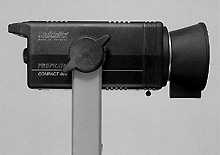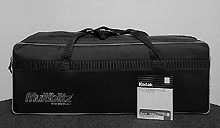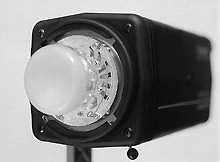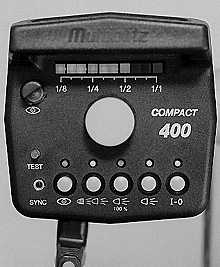
Multiblitz Profilite 400


One of the things that stood out when reviewing the Elinchrom/Prolinca monoblocs
a few months ago was the very compact nature of the kit. It therefore came
as some surprise to see Multiblitz making so bold as to use the "compact"
label in the name of its Profilite monoblocs Amazingly, Multiblitz does
indeed fit two lights, two reflectors, two brollies, two stands and all
the necessary cables, into one very neat 27 x 11 x 7in carrying bag. The
whole lot is rather heavy to carry in one hand, but it is SO convenient!
Inside the bag, a lift-up rigid divider separates the stands and brollies
above, from the monoblocs and cables below. This is a logical arrangement,
for it makes sense to erect the stands before unpacking the heads. The stands
have blade legs, rather than the more usual tubular type, and are well suited
to their purpose. Maximum stable extension is about 7ft 6in, reducing to
26in when folded down for carrying. These figures match those of the stands
supplied with the Elinchrom/Prolinca kit, which are actually about 25g lighter
(owing to the different leg design). As the editor has pointed out previously,
users can, of course, choose their own alternative stands if required, though
those offered by Multiblitz are the longest that will fit into the bag supplied.
Belt and braces
The monoblocs are provided with protective end caps and spare fuses p;
two factors that do much to endear the Multiblitz units to me. They are
also fitted with safety links, to which chains can be attached when using
overhead lighting rigs. Bearing in mind this possible use, it is good to
report that the L-shape support bracket is correctly sized to swing right
around the monobloc via the rear panel. Lights that are placed overhead
can therefore be arranged with their controls the right way up. Indeed,
this is one of the most important advantages of such brackets in comparison
with the stub mountings used by manufacturers such as Elinchrom and Prolinca.
Unfortunately, Systems Imaging's L-shape brackets, and Courtenay's Us, are
both designed not to allow full rotation. Bowens, on the other hand, has
got it right.

Although the Multiblitz Profilite housings are as compact as their name
suggests they should be, measuring 12in long with a 4.5in square cross-section,
the lights actually end up 25% longer when the brackets are folded down
for transportation. Even so, the units are still not large by general standards.
At 2.1kg, the weight isn't too bad either. In fact, it's the best in its
class (up to 400J) in terms of power per kilo (see table). Could the location-kit
crown, currently worn by Elinchrom/Prolinca, now be under threat?
Another big plus point in Multiblitz's favour p; though it is largely
an academic one, is the admission of what seems very likely to be a true
maximum power level (384J). I have always thought it improbable, given components'
discrete ratings, that all monoblocs specified at, say, 300J would actually
be exactly this. Multiblitz's figure sits much more comfortably p; though
the deviation from the model's 400 label (and nominal rating) amounts to
just 4%, which is less than the permissible variation in UK mains voltage.
It all matters little in practice, except that if figures are important
(and manufacturers who quote weights to two decimal places clearly believe
they are), then they should also be accurate.
I have compiled a table of comparative figures
for similar flash units here.
Styling
Multiblitz's overall styling is very German: almost Porsche-like to be specific.
In common with Systems Imaging and Courtenay, Multiblitz favours a black
and reddish livery (though I believe it was Multiblitz who had the idea
first). The support bracket is very chunky p; as is the user-friendly
winged locking nut that acts upon it. Underneath the housing are the positive-action
accessory locking lever and the mains power socket. Cooling slots are cut
into the casing above and below. It is possible that the slots could provide
easy access for dust, especially under the driving force of the in-built
fan. Although this is pure conjecture, it would surely have been no great
hardship (nor additional expense) to have had a filter fixed over the cooling
slots. For the record, the fan sucks air in through the housing and out
over the modelling lamp and flash tube, finally expelling through holes
cut into the frosted glass dome that protects the two. Personally, I would
have thought this was the wrong direction, given that lights often point
downwards to some degree, whereas hot air rises.

The rear control panel has a uniquely high-tech look thanks to an abundance
of LEDs, including a bar-graph display of output power. The main control
is a well sized rotating knob. There is no scale around the knob since its
position is reflected by the states of the LEDs. Indicators illuminate to
indicate the power level, glowing brightly when the unit is ready to fire
and more dimly during recycling. Sad to say, as read-outs go, this bright/dim
system is not terribly easy to use. The LED indicators respond immediately
to changes in levels, suggesting there should be no need to dump excess
power by hand when reducing output. In fact, the indicators are misleading
in this respect: when setting up lighting, users would be well advised to
fire a preliminary pop to ensure that the levels really are as expected
before taking exposure readings.
As is the norm in this type of arrangement, modelling lamps can be off,
at full power, or proportional to the flash setting. Modelling lights can
also be set to go down automatically after firing. These options take up
most of the push-button controls that line the bottom of the rear panel,
being joined only by a master on/off switch on the right and a slave cell
on/off switch on the left. Like Broncolor, Multiblitz favours a small miniature
sync connector over the more common Bowens-size plug. The socket is located
directly below the test button, which is, of those I have encountered so
far, the easiest to find and fire without looking.
Although the reflectors supplied in the compact kit are very small, they
are also very tough. Subjected to a cautiously applied 'reviewer standing
on one foot balanced on top of the reflector' test, the Multiblitz umbrella
reflectors passed with flying colours. The umbrellas themselves are also
worthy of note, being rubberised on the outside and having rounded balls
that make the protruding tip much less hazardous than it would otherwise
be. If they have a weakness, it would probably prove to be the tie that
secures the fabric when closed, for this seems to be rather thin and insubstantial.
In terms of performance, the Profilite 400 suffers from the same problem
as the Broncolor C80: it lacks protection against firing at less than full
charge. As was pointed out last month, this could be either a strength or
a weakness, depending on how important it is to capture one particular frame
- albeit at less than the ideal exposure. In terms of the criteria laid
down for these tests, however, this apparent lack of tight control is regarded
as a weakness. Claimed recycling times for the Multiblitz 400 vary from
0.7s to 2s, with durations from 1/600s to 1/900s.
The range of Profilite accessories is more than sufficient for most purposes.
It includes, for example, a background reflector, a softlite reflector and
a rigid softbox that can be fitted with honeycombs if required. If all these
are built to the same standard as the umbrella reflector tested, then they
ought to last a lifetime at least.
Overall, Multiblitz Profilites look very good and show signs of very careful
design thought. But there are weaknesses too. Final judgement therefore
rests on the price: £518 (before VAT) for a single 400J head, rising
to £1,250 for the two head kit tested here, is simply too much in comparison
with the competition.
SUMMARY RATINGS
* Aesthetic & Ergonomic Design: Very Good
* Range of Accessories: Good
* Capital and Running Costs: Poor
* Performance: Fair
* Overall Rating: German build quality, compact proportions and a clean
stylish look. Unfortunately, also very expensive.




